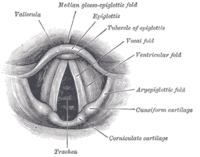
Photo from wikipedia
The extracellular matrix (ECM) is essential for the maintenance of tissue architecture, anchoring cells and sustaining normal tissue function. Cells sense and functionally respond to their physical three-dimensional (3D) environment… Click to show full abstract
The extracellular matrix (ECM) is essential for the maintenance of tissue architecture, anchoring cells and sustaining normal tissue function. Cells sense and functionally respond to their physical three-dimensional (3D) environment by translating ECM interactions, as well as mechanical forces and deformations, into subsequent cell signalling events. Imbalances in these reciprocal interactions between cells and their ECM perturb normal cellular function and contribute to a diverse range of respiratory diseases, including those associated with abnormal lung development, acute lung injury, pulmonary fibrosis, airway remodelling and cancer [1]. The aim of the European Respiratory Society (ERS) Lung Science Conference (LSC) 2018 was to provide a state-of-the-art review of current understanding of the role of the perturbations of cell–matrix interactions as determinants of cell fate and function across the spectrum of respiratory diseases and lung regeneration. The conference took place on March 8–11, 2018 in Estoril, Portugal, and was regarded as an outstanding forum for the discussion of novel scientific concepts on cell–matrix interactions as well as their dysregulation in lung disease. Imbalances in cell–matrix interactions perturb normal cell function and contribute to a range of respiratory diseases, including those associated with abnormal lung development, acute lung injury, pulmonary fibrosis, airway remodelling and cancer http://ow.ly/AVXi30k3QPT
Journal Title: European Respiratory Review
Year Published: 2018
Link to full text (if available)
Share on Social Media: Sign Up to like & get
recommendations!